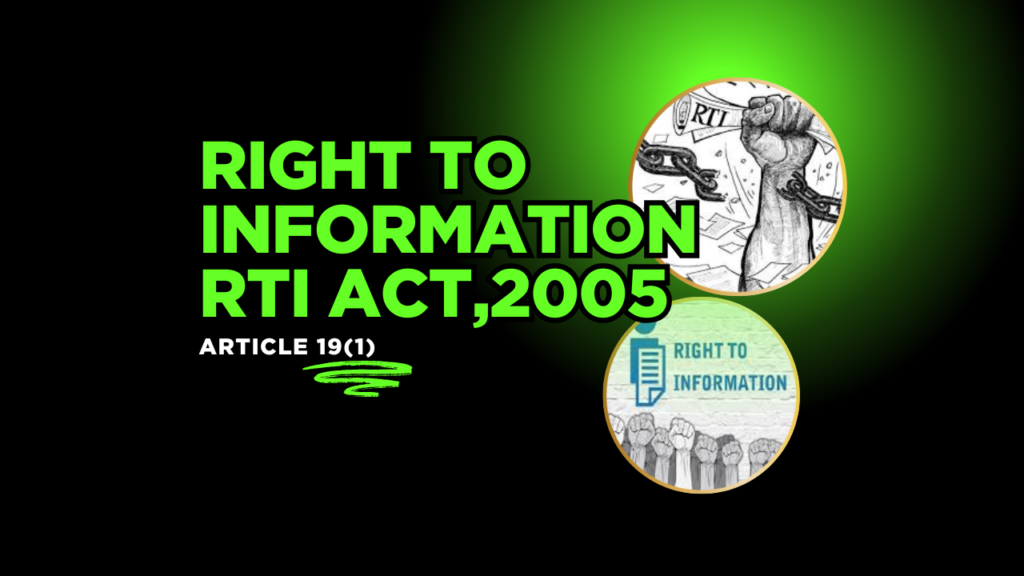The Right to Information (RTI) Act, enacted in 2005, represents a cornerstone in India’s commitment to transparency, accountability, and good governance.
The Act provides citizens the power to request information from public authorities, thereby ensuring that the government remains open and answerable to the people. Understanding the RTI Act is not just about filing requests but also about recognizing its constitutional foundation and how it intersects with other legal frameworks in India.
Right to Information (RTI) Act
While the RTI Act itself was passed by the Indian Parliament in 2005, its roots lie in the Constitution of India and earlier judicial rulings. The Constitution does not explicitly provide a “Right to Information” as a fundamental right, but the Supreme Court of India has interpreted the right to information as being an essential part of the Right to Freedom of Speech and Expression under Article 19(1)(a).
Article 19(1)(a): Freedom of Speech and Expression
Article 19 of the Indian Constitution guarantees the freedom of speech and expression to all citizens. In its interpretation, the Supreme Court of India has observed that the right to information is a crucial element of this fundamental right. The Court held that the right to information is necessary for the full and effective exercise of freedom of speech, enabling citizens to make informed decisions.
In the landmark case of “Union of India v. Association for Democratic Reforms (2002)”, the Supreme Court recognized that access to information about public institutions is vital for citizens to participate meaningfully in governance. Thus, while the Constitution does not explicitly mention the Right to Information, the judiciary has strongly supported its link with the fundamental rights provided under Article 19.
Directive Principles of State Policy (DPSP)
While Article 19(1)(a) ensures freedom of expression, Article 51A of the Constitution under the Directive Principles of State Policy emphasizes the importance of the role of citizens in promoting justice, equality, and democracy. Transparency in governance directly aligns with the principles of fostering a just society, empowering individuals, and enhancing democratic functioning.
How the RTI Act Works: A Step-by-Step Guide
Understanding how to use the Right to Information (RTI) effectively involves more than just knowing the provisions; it’s about knowing how to navigate the RTI process efficiently. The following sections will guide you through the process.
How to File an RTI Application
- Identify the Relevant Public Authority
Before you file an RTI request, identify which public authority holds the information you need. This could be a Central Government Ministry, State Government Department, or any public sector undertaking or local authority. - Drafting the RTI Request
Your RTI application must be in writing. It should contain:- A brief description of the information you are seeking.
- The name of the public authority where the information is held.
- Your contact details.
- RTI Fees and Charges
While RTI fees and charges are generally modest, they vary by state and the type of information you are requesting. The standard fee is usually ₹10 for filing an RTI application. Additional charges may apply for photocopies or electronic copies of documents.- Example: Photocopies are often charged at ₹2 per page, and if you want documents sent via post, you might need to cover the postal expenses.
- Submit the RTI Application
Once drafted and signed, submit the application to the concerned public authority. The authority will process it within the prescribed timeline.
What Happens Next?
- Acknowledgement: You will receive an acknowledgement that your RTI request has been received, either with a reference number or through an online tracking system.
- Response Time: As per the RTI Act, the government must respond within 30 days. For life and liberty-related requests, the response time is shortened to 48 hours.
RTI Exemptions: What Information Cannot Be Disclosed?
While the RTI Act empowers citizens, there are specific RTI exemptions that allow the withholding of certain types of information. The RTI exemptions list includes:
- National Security: Information that, if disclosed, would harm national security or affect defense interests.
- Personal Information: Information that pertains to an individual’s personal life, unless it pertains to public interest.
- Trade Secrets: Commercial secrets of businesses or government departments.
- Law Enforcement: Any information that could impede investigations or lead to interference with justice.
- Public Order: Any information that, if disclosed, might lead to public unrest or disturbance.
These exemptions ensure that sensitive information is protected, but citizens are still empowered to seek information that serves public interest.
RTI Appeals Process: What If Your Request Is Denied?
In cases where your RTI request is either denied, ignored, or not answered satisfactorily, you have the right to appeal. The RTI appeals process is designed to ensure transparency in how information is managed:
- First Appeal: If your request is not answered or is denied within the stipulated time, you can file a first appeal with the appellate authority of the public authority.
- Second Appeal: If the first appeal is also not satisfactorily resolved, you can file a second appeal with the Central Information Commission (CIC) or State Information Commission (SIC), which acts as the final adjudicator.
The RTI Act mandates that a decision must be provided within 30 days of filing the second appeal.
Understanding RTI Success Stories
Many RTI success stories highlight how individuals and organizations have used the RTI Act to bring about significant changes. These stories emphasize the power of transparency in combating corruption and improving governance. Here are a few notable examples:
- Corruption in Government Schemes: In one case, an RTI request uncovered the misuse of funds meant for rural development, leading to an investigation by authorities.
- Educational Transparency: Students used RTI to request information about the qualifications of faculty members at a prominent university, exposing discrepancies and resulting in reforms.
- Environmental Accountability: Environmentalists used RTI to reveal illegal construction projects that violated environmental norms, prompting legal action and halting the projects.
These success stories show how the RTI Act can be a powerful tool for citizens seeking justice and accountability.
Constitutional and Legal Documents Related to RTI
- The Constitution of India (Article 19):
Article 19(1)(a) guarantees the Right to Freedom of Speech and Expression, which has been interpreted by the judiciary to include the Right to Information. This forms the constitutional basis of the RTI Act. - The RTI Act (2005):
This is the primary legal document that provides the framework for filing requests, receiving information, and addressing appeals. It ensures that all government bodies, including ministries, state governments, and public sector undertakings, are accountable to the public. - Judicial Precedents:
- Supreme Court of India in “Union of India v. Association for Democratic Reforms (2002)”: The Court recognized the right to information as an essential part of freedom of speech and expression.
- Delhi High Court in “Subhash Chandra Agarwal v. Union of India (2011)”: This case extended the scope of RTI by allowing citizens to seek information about the personal assets of public officials.
- The Central Information Commission (CIC) and State Information Commissions (SIC):
These bodies serve as the final adjudicators in cases of RTI disputes and ensure that public authorities comply with the Act.
The Right to Information (RTI) Act is a powerful tool for strengthening democracy in India by making the government more transparent and accountable. It is deeply rooted in the Constitution of India and the Right to Freedom of Speech and Expression. By understanding the RTI process, the RTI appeals process, and RTI exemptions, citizens can effectively use the Act to demand information and challenge corruption or inefficiency.
While the Act allows citizens to file RTI applications, knowing how to do so effectively, understanding related legal documents, and being aware of RTI fees and charges can significantly enhance its utility. With constitutional backing, legal precedence, and the support of the Central Information Commission, the RTI Act continues to be an essential tool for ensuring transparency and justice in Indian governance.
—–Frequently Asked Questions (FAQ’s)—–
What are the time limits for the RTI response?
As per the RTI Act, the time limit for responding to an RTI request is 30 days. However, if the information pertains to matters related to life or liberty, the response time is 48 hours. If no response is received within the prescribed time, it is considered a “deemed refusal.”
What is the fee for filing an RTI application?
RTI application fee is generally ₹10. Additional charges may apply for photocopying documents (around ₹2 per page) or for postal expenses. Fees can be waived for individuals from the BPL (Below Poverty Line) category.
How can I check the status of my RTI application?
Many public authorities allow you to track the RTI status online by visiting their official website and entering the reference number provided when you filed your RTI request. You can also contact the public authority via phone or email to inquire about your application’s status.
What happens if my RTI request is denied or not answered?
If your RTI request is denied or not answered within the prescribed time (30 days), you can file an RTI appeal. The appeals process has two levels: First Appeal: If your application is rejected or unanswered, appeal to the first appellate authority within 30 days.Second Appeal: If the first appeal is unsatisfactory, you can file a second appeal with the Central Information Commission (CIC) or State Information Commission (SIC).
Is the RTI Act applicable to all public bodies in India?
Yes, the RTI Act applies to all government bodies at the central, state, and local levels. This includes ministries, public sector undertakings, local authorities, and any body funded or controlled by the government.


